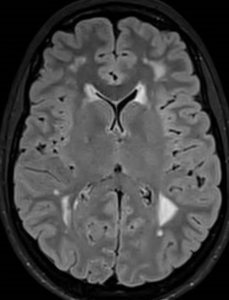CSF1R-related leukodystrophy is likely the second most common leukodystrophy in adults and is often mistaken for multiple sclerosis.
Leukodystrophies are genetic diseases of the brain white matter
The term “leukoencephalopathy” refers to a pathological process that affects the synthesis or the degradation of the white matter in the central nervous system (brain and spinal cord). White matter consists of nerve fibers that interconnect neurons. These nerve fibers are wrapped and protected by an insulating layer called myelin, which is made up of proteins and lipids. These proteins and lipids give myelin its characteristic white color. Myelin provides nutritional support to neurons and enables the rapid conduction of nerve impulses. Therefore, myelin facilitates the transmission of information from the brain to the periphery and vice versa. Myelin is also known as the myelin sheath.
Leukodystrophies are genetic forms of leukoencephalopathies, meaning they are rare inherited neurological diseases that impair the synthesis or maintenance of myelin. Leukodystrophies primarily affect glial cells, which are of three types:
- Oligodendrocytes
- Astrocytes
- Microglia
Simply put, oligodendrocytes synthesize the myelin sheath; astrocytes provide nutritional support to oligodendrocytes and neurons, while microglial cells ensure the immune defense of the nervous system. All these cells are essential for the synthesis and renewal of myelin.

Summary
What causes leukodystrophies?
Leukodystrophies are caused by genetic abnormalities called mutations in genes that code for proteins playing a key role in myelin synthesis or maintenance. Myelin is an ultra-specialized membrane composed of proteins and lipids that need to be produced and renewed throughout life. Mutations in a gene involved in one of these processes in glial cells compromise the synthesis and/or maintenance of myelin, leading to a decrease in the amount of myelin and/or impaired myelin function. To date, more than 200 genes have been identified as causes of leukodystrophies.
There are typically two types:
- Hypomyelinating leukodystrophies (insufficient production of myelin)
- Demyelinating leukodystrophies (defects in myelin maintenance leading to myelin loss)
Leukodystrophies are generally progressive neurodegenerative diseases that can manifest in early childhood, adolescence, or adulthood. Among the most common, our center manages leukodystrophies such as X-linked adrenoleukodystrophy (ALD), CSF1R-related leukodystrophy (ALSP), metachromatic leukodystrophy (MLD), Krabbe disease, cerebrotendinous xanthomatosis (CTX), Alexander disease, EIF2B-related leukodystrophies (vanishing white matter diseases), PLP1-related leukodystrophy, and GJA1-related leukodystrophy.
What are the symptoms of leukodystrophies?
Leukodystrophies compromise the function of the myelin sheath. This results in a loss of communication between neurons and the onset of motor, cognitive, psychiatric, and/or sensory symptoms. Symptoms experienced by patients vary depending on the type of leukodystrophy and the severity of the condition. However, common clinical signs include motor symptoms such as spasticity (muscle stiffness), ataxia (lack of coordination in voluntary movements), speech disorders, and abnormal movements like dystonia (involuntary muscle contractions) or tremors. These motor disorders are often associated with bladder control difficulties. Cognitive symptoms may include psychomotor developmental delays, learning difficulties, or, in severe cases, dementia. Behavioral or mood disorders are also frequent. Vision and/or hearing problems may occur, particularly in children.

How are leukodystrophies diagnosed?
The diagnosis of leukodystrophies primarily relies on brain imaging (MRI), which highlights myelin abnormalities and helps classifying leukodystrophies as hypomyelinating or demyelinating. A more precise diagnosis of the type of leukodystrophy is based on biochemical tests for certain leukodystrophies and genetic analyses in all cases. Once the diagnosis is made, genetic counseling is offered to families to determine the relatives at risk of developing or transmitting the disease to their offspring. In adults, leukodystrophies are often misdiagnosed as multiple sclerosis, the most common and well-known myelin disorder among neurologists.
What treatments are available for leukodystrophies?
For some leukodystrophies, specific treatments are available, such as bone marrow transplants for ALD, ALSP, and certain forms of MLD and Krabbe disease. The transplant must be performed at an early stage of the disease to be effective. In some cases, medications are available, as in CTX. Several gene therapies are also under development for leukodystrophies.
Additionally, for all leukodystrophies, symptomatic treatments, both medicinal and rehabilitative, can help alleviate symptoms like spasticity or pain.
The different types of leukodystrophies
Metachromatic Leukodystrophy
Metachromatic leukodystrophy is an autosomal recessive disease that affects both children and adults.
X-linked Adrenoleukodystrophy
X-linked adrenoleukodystrophy is the most common leukodystrophy in males of all ages.
Cerebrotendinous Xanthomatosis
Cerebrotendinous xanthomatosis is an autosomal recessive disease that often begins in childhood but frequently diagnosed only in adulthood.
